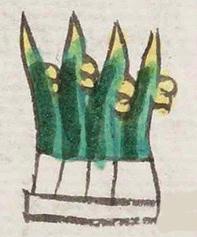Tollan (Mdz8r)
This simplex glyph for the place name Tollan also doubles as the glyph for tolin, reeds or rushes. This glyph consists of four upright or vertical reeds connected by a white base. The reeds are also white toward the bottom of the stalks. At the top of the reeds, small, yellow, rounded shapes appear.
Stephanie Wood
This simplex glyph stands for the place name Tollan, represented simply by rushes (tolin). The white component at the base of the tules is reminiscent of the base of feathers, when grouped, as we see in the various groups of colored feathers in the Codex Mendoza on folio 47 recto. The -tlan (locative suffix) of the place name Tollan is not expressed visually unless the white base of the reeds suggests teeth (tlantli). As with other stems ending in "l," in this case tol-, when the locative suffix -tlan is added, the middle "t" drops out of the combination of tol + tlan, creating tollan, "near the rushes." Gordon Whittaker refers to Tollan as a place name that was the equivalent of "the centre of the universe," and was probably the name for Teotihuacan, an earlier name for Tenochtitlan, Xicocotitlan (Tula today), and Cholollan (Cholula today). (Source: Whittaker, "The Study of North American Place Signs," Indiana 13 (1993), 9–38.)
Stephanie Wood
tulan puo
Tollan, pueblo
Stephanie Wood
c. 1541, or by 1553 at the latest
Stephanie Wood
tolan, toli, tolli, tollin, tolin, reeds, sedges, bulrushes, tules, nombres de lugares

tol(in), rushes or tules, https://nahuatl.wired-humanities.org/content/tolin-1
-tlan (locative suffix), https://nahuatl.wired-humanities.org/content/tlan
Codex Mendoza, folio 8 recto, https://digital.bodleian.ox.ac.uk/objects/2fea788e-2aa2-4f08-b6d9-648c00..., image 26, of 188.
The Bodleian Libraries, University of Oxford, hold the original manuscript, the MS. Arch. Selden. A. 1. This image is published here under the UK Creative Commons, “Attribution-NonCommercial-ShareAlike 3.0 License” (CC-BY-NC-SA 3.0).







